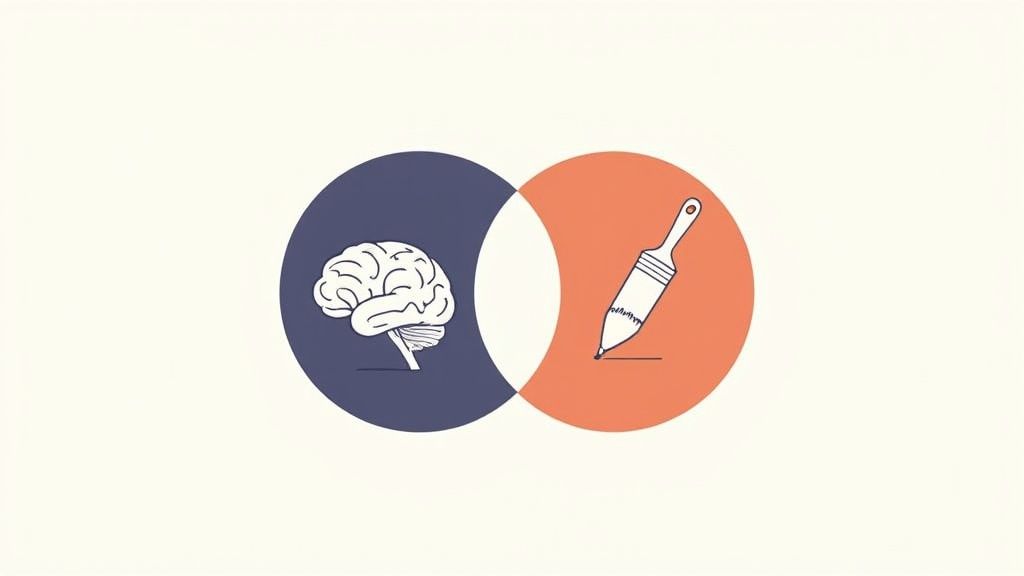Unleash Your Unique Value: Crafting a Personal Brand Statement That Resonates
Ready to make a real impact? A strong personal brand starts with a powerful statement. This listicle provides seven personal brand statement examples to help solopreneurs, creators, career pivoters, coaches, and purpose-driven professionals define their unique value. Whether you're an expert in your field, a passionate problem-solver, or a niche specialist, learn how to craft a statement that resonates with your target audience and sets you apart. Explore these examples and discover the perfect formula to showcase your strengths and attract the right opportunities.
1. The Expertise Statement
Want to position yourself as a go-to expert in your field? The Expertise Statement is your personal branding secret weapon. This type of personal brand statement shines a spotlight on your specialized skills, knowledge, and professional capabilities, instantly communicating your value to potential clients or employers. It's a powerful way to establish credibility and demonstrate your mastery of a specific area, making you a sought-after authority.

This approach works by showcasing the depth and breadth of your professional expertise. Think of it as your elevator pitch amplified – it's a concise declaration of what you do best and the unique value you bring to the table. Whether you’re a solopreneur building a service business, a career pivoter seeking new opportunities, or a consultant attracting ideal clients, the Expertise Statement clarifies your position in the market and makes you instantly recognizable for your specific strengths. For technical fields and specialized industries, this is often the most effective way to cut through the noise and demonstrate your worth.
Features of an Expertise Statement:
- Emphasis on professional capabilities and specialized knowledge: It's all about what you know and what you can do.
- Inclusion of technical skills or industry-specific expertise: This is where you get specific and showcase your niche.
- Clear communication of a value proposition based on competence: You’re not just skilled; you bring tangible value to the table.
- Often includes credentials or qualifications: Adding certifications or degrees further solidifies your authority.
Examples of Effective Expertise Statements:
- Award-winning financial analyst with 10+ years of experience translating complex data into actionable investment strategies for Fortune 500 companies.
- Certified cybersecurity expert specializing in threat detection and vulnerability assessment for healthcare systems, protecting sensitive patient data from emerging threats.
Pros:
- Instantly communicates professional value.
- Establishes credibility quickly.
- Works well for technical fields or specialized industries.
- Clear positioning for specific roles or opportunities.
Cons:
- Can sometimes feel impersonal or too technical.
- May not differentiate you from others with similar skills (mitigate this with specific achievements and quantifiable results).
- Needs regular updating as skills and industry terminology evolve.
- Might limit opportunities outside your stated expertise area (consider broadening if you desire versatility).
Tips for Crafting Your Own Expertise Statement:
- Focus on your most advanced or unique skills: What truly sets you apart?
- Quantify your expertise with years of experience or measurable achievements: Numbers speak volumes. Don't just say you're "experienced"; say "10+ years of experience generating $X in revenue."
- Use industry-specific terminology appropriately: Speak the language of your target audience.
- Update regularly as you gain new certifications or expertise: Your statement should evolve alongside your career.
Who Popularized This?
You'll find variations of the Expertise Statement used effectively by industry experts in their LinkedIn profile summaries, by professional speakers and consultants like Neil Patel, and by technical thought leaders across various industries.
The Expertise Statement earns its place on this list because it's a foundational approach to personal branding for those who want to be recognized for their deep knowledge and skills. It provides a clear, concise, and compelling way to communicate your value and attract the right opportunities. Whether you're a coach looking to attract ideal clients, a creator finding their niche, or a career pivoter seeking a fresh start, the Expertise Statement can be the key to unlocking your professional potential.
2. The Problem-Solver Statement
The Problem-Solver personal brand statement is your chance to shine as a beacon of hope for your target audience. It's about showcasing your ability to understand and address their specific pain points, positioning you as the go-to solution provider. This approach moves beyond simply listing your skills and dives straight into the heart of the value you deliver. It answers the crucial question: "What problem do you solve?" By focusing on the positive outcomes you create, you immediately resonate with potential clients or employers who are actively seeking those very solutions.

This method works by directly addressing the challenges your target audience faces. Instead of saying "I'm a web developer," a problem-solver statement might say "I help small businesses establish a powerful online presence that attracts new customers and drives revenue growth." See the difference? The first statement simply states a skill; the second paints a picture of transformation and desired outcomes. It speaks directly to the aspirations of a small business owner struggling to gain traction online. This is particularly effective for solopreneurs building service businesses, aspiring creators looking to define their niche, and career pivoters seeking to showcase their new direction.
Features of a Strong Problem-Solver Statement:
- Focuses on Outcomes: Emphasizes the results and benefits clients receive, not just the processes you use.
- Target Audience Focused: Clearly identifies the specific audience and their unique challenges.
- Results-Oriented: Quantifies impact with metrics and proof elements whenever possible.
Examples of Problem-Solver Personal Brand Statements:
- I help small e-commerce businesses increase conversion rates by 30% through data-driven UX optimization and strategic A/B testing that turns browsers into buyers. (Focuses on a specific metric and desired outcome.)
- I transform underperforming sales teams into revenue-generating powerhouses by implementing customized training systems that address the psychological barriers to closing deals. (Highlights a transformation and addresses a core challenge.)
Pros:
- Immediate Relevance: Directly addresses the needs of your target audience.
- Compelling Narrative: More engaging than simply listing qualifications.
- Emotional Connection: Resonates with clients by acknowledging their pain points.
- Demonstrates Value: Showcases practical expertise and tangible results.
Cons:
- Narrow Focus: Can sometimes limit your perceived range of capabilities.
- Requires Refinement: Needs ongoing updates as market challenges evolve.
- Conciseness Challenge: Can be difficult to capture complex solutions succinctly.
Tips for Crafting Your Problem-Solver Statement:
- Identify Key Problems: Research the most pressing challenges your ideal client faces.
- Quantify Your Impact: Use metrics to demonstrate the value you provide.
- Focus on the End Result: Emphasize the positive transformation you deliver.
- Test and Refine: Experiment with different versions to find the most resonant message.
This approach, popularized by thought leaders like Peter Drucker and Seth Godin, as well as consultative sales professionals, deserves its place on this list because it's a powerful way to connect with your audience on a deeper level. It's particularly impactful for coaches and consultants seeking to attract the right clients and purpose-driven professionals looking to align their work with a meaningful mission. By focusing on the problems you solve and the value you deliver, you create a personal brand statement that not only attracts attention but also inspires action.
3. The Passion-Driven Statement
Are you yearning to infuse your personal brand statement with authentic meaning and purpose? The Passion-Driven Statement is your answer. This approach goes beyond simply listing your skills and experience; it delves into the why behind your work, connecting your deepest values with your professional aspirations. It's about communicating the positive impact you want to make on the world, resonating with those who share your vision and attracting opportunities aligned with your true calling.

This method works by weaving together your personal motivations, your professional skills, and the tangible difference you strive to create. It often uses aspirational language, painting a picture of the future you're working towards. For solopreneurs, creators, career pivoters, coaches, and purpose-driven professionals, this approach offers a powerful way to stand out from the crowd and connect with your ideal audience. This is why it deserves its place in this list of impactful personal brand statement examples.
Features of a Passion-Driven Statement:
- Highlights personal motivation and driving purpose: It showcases the fire within you, the force that propels you forward.
- Often includes aspirational language: It inspires and invites others to join your journey.
- Connects personal values to professional work: It demonstrates the congruence between who you are and what you do.
- Emphasizes impact beyond financial or career success: It focuses on the legacy you want to leave.
Pros:
- Creates emotional connection with like-minded clients or employers: It fosters a sense of shared purpose and belonging.
- Differentiates you from competitors with similar skills: It highlights your unique contribution and value proposition.
- Appeals to organizations and clients with strong values alignment: It attracts those who resonate with your mission.
- Often more memorable than purely skill-based statements: It leaves a lasting impression, making you unforgettable.
Cons:
- May appear less practical or business-focused to some audiences: It requires a careful balance between passion and pragmatism.
- Can sometimes come across as idealistic rather than pragmatic: Ground your aspirations with tangible achievements and credible evidence.
- Needs to be balanced with credibility elements: Showcase your expertise alongside your passion.
- Not ideal for all industries or professional contexts: Certain highly technical or data-driven fields might require a more direct approach.
Examples of Passion-Driven Personal Brand Statements:
- Dedicated environmentalist and renewable energy engineer committed to designing sustainable infrastructure solutions that help communities thrive while preserving our planet for future generations.
- Passionate advocate for educational equity who develops adaptive learning technologies that empower underserved students to overcome systemic barriers and achieve their fullest potential.
Tips for Crafting Your Own Passion-Driven Statement:
- Connect your personal story to your professional mission: Share the experiences that shaped your purpose.
- Be authentic about your motivations and values: Let your true self shine through.
- Balance passion with practical credentials or accomplishments: Demonstrate your expertise and credibility.
- Consider how your purpose aligns with the needs of your target audience: Speak directly to their aspirations and challenges.
Inspiration and Influence:
The Passion-Driven Statement is heavily influenced by Simon Sinek's "Start With Why" philosophy, which emphasizes the importance of communicating your purpose. Social entrepreneurs like Blake Mycoskie (TOMS) and purpose-driven brands like Patagonia and their leadership also exemplify this approach. By focusing on the "why" behind your work, you can create a personal brand that is not only compelling but also deeply meaningful.
4. The Unique Combination Statement
Do you feel like a jack-of-all-trades, unsure how your diverse skills and experiences fit together into a cohesive personal brand? The Unique Combination Statement is your answer. This powerful approach to crafting a personal brand statement highlights the intersection of your seemingly disparate talents, turning what might be perceived as a weakness into your greatest strength. It showcases the unique value you bring to the table—a value that's difficult for others to replicate. This method works by identifying the unusual blend of your attributes and demonstrating how this combination creates a unique competitive advantage, ultimately attracting unique opportunities.

This personal brand statement example deserves a place on this list precisely because it empowers those with diverse backgrounds and multidisciplinary expertise. It's a beacon for solopreneurs building service businesses, aspiring creators finding their niche, career pivoters seeking new direction, coaches and consultants crafting their voice, and purpose-driven professionals searching for deeper meaning. It allows you to embrace the power of "and" instead of feeling confined by "or."
Features of a Unique Combination Statement:
- Identifies an uncommon combination of skills or experiences: Think about the things you do that most people don't do. What seemingly unrelated skills or passions do you possess?
- Highlights diverse background or multidisciplinary expertise: Your varied background is an asset, not a liability. This statement allows you to showcase the breadth of your knowledge.
- Shows unique perspective or approach: How does your unique blend of skills influence your approach to problem-solving or your perspective on your industry?
- Often includes seemingly contradictory strengths: Are you both analytical and creative? Technical and empathetic? Embrace the paradox!
Pros:
- Creates a clear differentiation from competitors: In a crowded marketplace, a Unique Combination Statement helps you stand out.
- Positions you for unique opportunities at the intersection of fields: You’re not limited to one path. This approach opens doors to innovative roles and projects.
- Harder for others to replicate your value proposition: Your unique blend of skills makes you invaluable and hard to replace.
- Often opens doors to innovative roles or projects: Organizations are increasingly seeking individuals with diverse skillsets to drive innovation.
Cons:
- Can sometimes be challenging to communicate concisely: It takes practice to distill your unique combination into a clear and compelling statement.
- May confuse audiences looking for conventional specialists: Some may not immediately understand the value of your diverse background.
- Requires explanation of how the combination creates value: Don't just list your skills; explain how they work together synergistically.
- Sometimes perceived as lack of focus rather than strategic advantage: You’ll need to clearly articulate the strategic advantage your combined skills provide.
Examples of Successful Implementation:
- Neuroscientist-turned-UX designer who combines brain research and behavioral psychology to create digital experiences that intuitively engage users and drive measurable behavior change. This statement highlights the unique blend of scientific and design expertise, showcasing a clear value proposition.
- Financial strategist with a creative writing background who transforms complex investment concepts into compelling narratives that help clients confidently navigate their financial futures. This example demonstrates how seemingly unrelated skills (finance and writing) can create a powerful and unique offering.
Tips for Crafting Your Own Unique Combination Statement:
- Identify your most unusual or seemingly unrelated skills/experiences: Brainstorm all your skills and passions, even those that seem irrelevant to your current career path.
- Explain how these elements complement each other: Don’t just list them; show the synergy. How do they work together to create something unique?
- Show specific examples of how this combination creates unique value: Use concrete examples to demonstrate the impact of your combined skills.
- Test your statement with people who don't know you well to ensure clarity: Get feedback to ensure your message is easily understood and resonates with your target audience.
This approach, popularized by thought leaders like David Epstein (author of Range) and Emilie Wapnick (who coined the term "multipotentialite"), champions the power of diverse skillsets. Like cross-industry innovator Elon Musk, you can leverage your unique combination of skills to achieve remarkable things. Don’t shy away from your diverse background—embrace it, and craft a personal brand statement that reflects your true value.
5. The Transformational Story Statement
Are you ready to connect with your audience on a deeper level? The Transformational Story Statement is a powerful approach to crafting personal brand statements that resonates with authenticity and inspires trust. This method leverages the power of your personal journey – your triumphs, challenges, and growth – to establish credibility and forge a strong connection with your target audience. This type of personal brand statement example works exceptionally well because it showcases not just your expertise, but the very journey that shaped it.
This approach uses a narrative structure, often following a 'before and after' framework, to illustrate your understanding of a particular challenge or process. By sharing your own experience of transformation, you create a sense of relatability with your audience, demonstrating that you've walked the path and emerged stronger on the other side. This makes the Transformational Story Statement particularly effective for solopreneurs, aspiring creators, career pivoters, coaches, consultants, and purpose-driven professionals who are looking to connect with their audience on a human level.
Features of a Transformational Story Statement:
- Incorporates elements of personal narrative: It's not just about stating facts; it's about sharing your story.
- Often follows a 'before and after' structure: This highlights the impact of your transformation.
- Establishes relatability through shared challenges: It shows your audience you understand their struggles.
- Demonstrates proof through personal experience: Your journey becomes evidence of your expertise.
Pros:
- Creates strong emotional connection with audience: Vulnerability fosters connection.
- Establishes authentic credibility through lived experience: Your story becomes your credential.
- Memorable due to narrative structure: Stories stick with people.
- Particularly effective for coaching, consulting, or helping professions: It positions you as a guide who has navigated similar terrain.
Cons:
- Requires vulnerability that may not be comfortable for everyone: Sharing personal details can feel exposing.
- Can sometimes overshadow professional qualifications: Ensure your skills and expertise are still highlighted.
- May not be appropriate for all professional contexts: Consider your industry and target audience.
- Risks oversharing or shifting focus away from client needs: Keep the focus on how your transformation benefits your clients.
Examples of Transformational Story Statements:
- Former corporate burnout turned wellness entrepreneur who helps high-achievers reclaim their health and happiness without sacrificing their ambition, using the same system that helped me lose 50 pounds and eliminate chronic stress.
- After building and losing a 7-figure business due to poor financial management, I now guide entrepreneurs through sustainable growth strategies that protect their companies from the devastating mistakes I learned the hard way.
These personal brand statement examples demonstrate the power of transforming personal struggles into a platform for helping others. They offer a glimpse into the journey, highlighting both the challenge and the triumph.
Tips for Crafting Your Own Transformational Story Statement:
- Share enough personal details to establish credibility but not so many that it becomes inappropriate: Find the sweet spot between vulnerability and professionalism.
- Focus on the transformation and lessons learned rather than dwelling on past struggles: Emphasize growth and empowerment.
- Connect your personal journey directly to how you help others: Make the relevance clear to your target audience.
- Include elements of your professional qualifications alongside your story: Balance personal narrative with demonstrable expertise.
Inspiration:
Think of individuals like Tony Robbins, who uses his personal transformation story to inspire millions, health and fitness influencers who document their own journeys to motivate others, or financial advisors like Dave Ramsey who leveraged personal financial recovery to build a trusted brand. These are prime personal brand statement examples of the power of this approach.
The Transformational Story Statement deserves its place on this list because it offers a uniquely powerful way to connect with your audience, build trust, and establish credibility. By embracing your story and showcasing your transformation, you can create a personal brand that resonates deeply and inspires action.
6. The Contrarian Statement
Are you tired of blending in? Do you see a better way to do things, a way that challenges the status quo? Then the Contrarian Statement might be the perfect personal brand statement example for you. This approach positions you as a bold, innovative thinker who isn't afraid to challenge conventional wisdom. It's about carving your own path and attracting clients who value fresh perspectives. This type of personal brand statement is especially effective for solopreneurs, aspiring creators, career pivoters, coaches/consultants, and purpose-driven professionals looking to make a real impact.
This method works by directly addressing industry norms and offering a different, often counterintuitive, approach. Instead of adhering to the accepted way of doing things, you highlight the flaws in the current system and present your unique solution. This immediately differentiates you and sparks interest. It's about being the voice that says, "There's a better way." This bold stance is particularly valuable in crowded markets, where standing out is crucial for success. It’s a powerful tool to create a distinct personal brand statement.
Here's how it works:
- Challenges Standard Assumptions or Practices: You actively question the effectiveness or relevance of commonly accepted practices within your industry.
- Takes a Bold Stance on Industry Issues: You aren't afraid to express strong opinions and offer alternative solutions, even if they're controversial.
- Often Includes a Critique of Status Quo Approaches: You pinpoint the shortcomings of traditional methods and explain why your approach is superior.
- Positions You as an Innovative Thinker: You establish yourself as someone who isn't afraid to think outside the box and push boundaries.
Examples of Successful Implementation:
- Marketing strategist who believes most companies waste 80% of their advertising budget on vanity metrics. I help mid-size businesses redirect resources to the proven, unsexy tactics their competitors are too caught up in trends to notice. This statement directly challenges the prevalent focus on vanity metrics and positions the strategist as a results-oriented practitioner.
- Executive coach who rejects the hustle culture narrative and instead helps C-suite leaders achieve more by working less, using counterintuitive productivity methods that prioritize recovery and strategic thinking over busyness. This statement takes a stand against the pervasive "hustle culture" and offers a refreshing alternative focused on sustainable productivity. This is a great example of a personal brand statement for coaches.
Pros:
- Immediately Differentiates You From Competitors: In a sea of sameness, a contrarian stance makes you stand out.
- Attracts Clients or Employers Looking for Fresh Perspectives: You become a magnet for those seeking innovative solutions and unconventional approaches.
- Creates Strong Positioning in Crowded Markets: You carve out a unique niche and establish yourself as a thought leader.
- Often Generates Interest and Conversation: Your bold stance sparks curiosity and invites discussion.
Cons:
- May Alienate Traditional or Conservative Audiences: Not everyone is ready to embrace unconventional ideas.
- Requires Strong Evidence to Back Up Contrarian Claims: You need data and results to support your position.
- Can Create Resistance or Skepticism That Needs to Be Overcome: Be prepared to address doubts and objections.
- Needs Regular Refinement as Industry Norms Evolve: Your contrarian stance should be based on current best practices and evolving trends.
Tips for Crafting Your Contrarian Personal Brand Statement:
- Ensure your contrarian position is based on evidence and experience, not just for shock value. Authenticity is key.
- Be prepared to defend your stance with examples and results. Back up your claims with concrete evidence.
- Focus on how your different approach creates better outcomes. Highlight the benefits of your unconventional methods.
- Identify which audiences will be most receptive to your contrarian view. Tailor your message to resonate with your target market.
Popularized By:
- Marketing expert Gary Vaynerchuk
- Investor and entrepreneur Peter Thiel with his 'Zero to One' philosophy
- Leadership author Simon Sinek challenging management conventions
The Contrarian Statement deserves its place on this list of personal brand statement examples because it offers a powerful way to cut through the noise and position yourself as a true innovator. If you're passionate about challenging the status quo and offering fresh perspectives, this approach can help you build a strong personal brand that attracts the right clients and opportunities.
7. The Niche Specialist Statement
Are you ready to become the undeniable authority in your field? The Niche Specialist Statement is your pathway to standing out in a crowded marketplace. This personal brand statement example empowers you to position yourself as the go-to expert for a highly specific niche, attracting ideal clients and commanding premium prices. Instead of trying to be everything to everyone, this approach allows you to laser-focus your expertise and become indispensable to a select group. This is one of the most powerful personal brand statement examples for anyone looking to truly own their space.
This approach works by showcasing your deep understanding of a specialized audience's unique challenges and needs. It’s about speaking directly to their pain points with the confidence and authority that comes from dedicated focus. Imagine the impact of a personal brand statement that resonates deeply with your target audience because it speaks their language and offers solutions no one else provides.
Features of a Niche Specialist Statement:
- Laser Focus: Targets a very specific market segment or specialty area.
- Specialized Language: Often includes industry or technical terminology relevant to the niche.
- Clear Boundaries: Clearly defines the boundaries of your expertise.
- Deep Understanding: Communicates a deep understanding of specialized needs.
Examples:
-
Before: "I'm a tax strategist helping small businesses."
-
After (Niche Specialist): "Tax strategist exclusively serving private practice orthodontists, with specialized knowledge of equipment depreciation, practice acquisition structures, and retirement planning optimized for the unique cash flow patterns of orthodontic businesses."
-
Before: "I'm a UX researcher improving user interfaces."
-
After (Niche Specialist): "UX researcher focusing solely on banking apps for seniors, combining gerontology expertise with financial interface design to create age-friendly digital experiences that increase adoption among users 65+."
These personal brand statement examples demonstrate the power of specificity. They clearly communicate the unique value proposition offered to a targeted audience.
Why This Approach Deserves Its Place in the List:
For solopreneurs, aspiring creators, career pivoters, coaches, consultants, and purpose-driven professionals, the Niche Specialist Statement provides unparalleled clarity and focus. It cuts through the noise and positions you as the expert in a specific area, making it easier for your ideal clients to find you and choose you over the competition.
Pros:
- Reduced Competition: Focus on underserved markets means less competition for clients.
- Premium Pricing: Specialized expertise commands higher fees.
- Strong Recognition: Become a recognizable authority within your niche.
- Referrals: Generate strong word-of-mouth referrals within the specialty area.
Cons:
- Limited Market Size: Focusing on a niche can limit your overall market size.
- Market Vulnerability: Changes or downturns in your niche can impact your business.
- Expansion Difficulty: Expanding beyond your niche can be challenging.
- Continuous Learning: Requires staying up-to-date with developments in your specialized field.
Actionable Tips for Creating Your Niche Specialist Statement:
- Identify a Profitable Niche: Choose a niche with sufficient demand but limited expert supply.
- Deep Dive into the Niche: Demonstrate a deep understanding of the niche's specific challenges.
- Speak Their Language: Use terminology and examples that resonate specifically with your target audience.
- Network Strategically: Build relationships with adjacent service providers to your niche.
Inspiration and Influence:
This strategy draws inspiration from marketing consultant Jay Abraham's specialty focus strategy and author Russell Brunson's advocacy for niche authority. Many successful professional services firms also leverage highly specialized practice areas to attract high-value clients.
By embracing the Niche Specialist Statement, you aren't just building a personal brand; you're building a powerful platform for growth, impact, and long-term success. This is your opportunity to shine as the expert you are meant to be.
7 Personal Brand Statement Types Compared
| Statement Type | Implementation Complexity 🔄 | Resource Requirements ⚡ | Expected Outcomes 📊 | Ideal Use Cases 💡 | Key Advantages ⭐ |
|---|---|---|---|---|---|
| The Expertise Statement | Medium – requires technical accuracy | Moderate – maintaining up-to-date skills | Clear authority and credibility in a field | Technical roles, specialized industries | Establishes credibility quickly and clearly |
| The Problem-Solver Statement | Medium-High – requires understanding client problems | Moderate – needs data and success metrics | Demonstrates practical value and measurable results | Client-focused roles, consulting, sales | Creates immediate relevance and emotional connection |
| The Passion-Driven Statement | Low-Medium – focus on values and storytelling | Low – centers on personal motivation | Emotional connection and memorable personal brand | Values-driven organizations, social enterprises | Differentiates by connecting purpose to work |
| The Unique Combination Statement | High – articulating uncommon intersections | Moderate – needs careful explanation | Differentiation through unique multidisciplinary skills | Innovative roles, cross-industry positions | Hard to replicate; opens unique opportunities |
| The Transformational Story Statement | Medium – involves personal narrative crafting | Low-Moderate – requires sharing personal journey | Strong emotional connection and authentic credibility | Coaching, consulting, helping professions | Memorable and relatable through personal experience |
| The Contrarian Statement | High – requires strong evidence and bold stance | Moderate – ongoing refinement and support | Differentiation by challenging norms | Markets valuing innovation and fresh perspectives | Attracts attention; positions as innovative thinker |
| The Niche Specialist Statement | Medium – focused on very specific expertise | Moderate – stays current in specialized area | Strong recognition and premium pricing in niche | Highly specialized industries, underserved markets | Reduces competition with deep specialization |
From Examples to Empowerment: Crafting Your Own Personal Brand Statement
These seven personal brand statement examples—from the Expertise Statement to the Niche Specialist Statement—offer a diverse toolkit for crafting a statement that truly captures your essence. We've explored how highlighting your problem-solving abilities, showcasing your passion, or sharing your unique transformational story can resonate deeply with your audience. The most important takeaways? Authenticity, conciseness, and memorability. Just like a well-crafted statement helped elevate brands, your personal brand statement can be your key differentiator—the compass guiding your solopreneur journey, creator platform, career pivot, coaching practice, or purpose-driven profession. Mastering this skill empowers you to not just tell your story, but to own it, attracting the right opportunities and building a brand that truly reflects your value.
Ready to transform your personal brand and unlock your full potential? Henri Den offers expert guidance and resources to help you craft a compelling personal brand statement that sets you apart. Visit Henri Den today and discover how to refine your message, amplify your voice, and build a brand that resonates.






